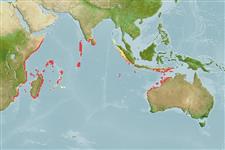Teleostei (teleosts) >
Blenniiformes (Blennies) >
Blenniidae (Combtooth blennies) > Salariinae
Etymology: Cirripectes: Latin, cirrus = curl fringe + Greek, pektos, -e, -on = made of several parts solidly united (Ref. 45335); gilberti: Named after Dr. Carter R. Gilbert (FSM)..
Environment: milieu / climate zone / depth range / distribution range
Ecology
Marine; reef-associated; depth range 0 - 8 m (Ref. 529). Tropical; 10°N - 30°S
Indian Ocean: South Africa, Comoro Islands, Agalega Islands, Seychelles, Chagos Archipelago, Cocos-Keeling Islands, Christmas Islands, and the northern tip of Sumatra.
Length at first maturity / Size / Weight / Age
Maturity: Lm ?, range 8 - ? cm
Max length : 10.2 cm SL male/unsexed; (Ref. 529)
Short description
Morphology | Morphometrics
Dorsal
spines
(total): 12;
Dorsal
soft rays
(total): 14;
Anal
spines: 2;
Anal
soft rays: 15;
Vertebrae: 30. Diagnosis: Dorsal fin XII, 14, membrane attached to caudal fin, with deep notch above last spine, first spine almost same or slightly higher than second; anal fin II, 15; pectoral rays 15; pelvic fin I, 4; caudal fin procurrent rays 11-14. Vertebrae 10 + 20. LL, without scales and scalelike flaps; LL tubes 0-3 (sometimes up to 5), canal ends below posterior to 9th dorsal ray, usually on caudal-fin base. Lower lip smooth mesially, plicate laterally. Upper lip crenulae 36-48. Gill rakers 24-30. Cephalic sensory pore system complex. Cirri, nuchal 50-64, supraorbital 17-48, nasal 11-37; nuchal cirri in 4 groups, where 2 or 3 groups are occasionally connected basally by a slightly notched frenum, usually dorsalmost groups overlap at middle of nape, ventralmost group on each side on expanded nuchal flaps. Body depth at anal-fin origin 3.0-3.8 in SL. Adult males with brown body; females greyish brown with red spots in life (Ref. 529, 90102).
Facultative air-breathing in the genus (Ref. 126274); Adults occur on rocky and coralline substrates at depths from near surface to 8 m (Ref. 529). Oviparous. Eggs are demersal and adhesive (Ref. 205), and are attached to the substrate via a filamentous, adhesive pad or pedestal (Ref. 94114). Larvae are planktonic, often found in shallow, coastal waters (Ref. 94114).
Life cycle and mating behavior
Maturity | Reproduction | Spawning | Eggs | Fecundity | Larvae
Oviparous, distinct pairing (Ref. 205). Urogenital orifice of male genital papilla located basally between 2 widely separated slender filaments on a fleshy swelling behind anus; testes bulbous with length equal to its width (Ref. 529).
Williams, J.T., 1988. Revision and phylogenetic relationships of the blenniid fish genus Cirripectes. Indo-Pac. Fish. (17):78 p. (Ref. 529)
IUCN Red List Status (Ref. 130435)
Threat to humans
Harmless
Human uses
Fisheries: of no interest
More information
Age/SizeGrowthLength-weightLength-lengthLength-frequenciesMorphometricsMorphologyLarvaeLarval dynamicsRecruitmentAbundanceBRUVS
ReferencesAquacultureAquaculture profileStrainsGeneticsElectrophoresesHeritabilityDiseasesProcessingNutrientsMass conversion
Tools
Special reports
Download XML
Internet sources
Estimates based on models
Preferred temperature (Ref.
123201): 25.2 - 28.9, mean 27.9 °C (based on 533 cells).
Phylogenetic diversity index (Ref.
82804): PD
50 = 0.5000 [Uniqueness, from 0.5 = low to 2.0 = high].
Bayesian length-weight: a=0.01072 (0.00480 - 0.02393), b=3.01 (2.82 - 3.20), in cm total length, based on LWR estimates for this (Sub)family-body shape (Ref.
93245).
Trophic level (Ref.
69278): 2.0 ±0.00 se; based on food items.
Resilience (Ref.
120179): High, minimum population doubling time less than 15 months (Preliminary K or Fecundity.).
Fishing Vulnerability (Ref.
59153): Low vulnerability (10 of 100).
